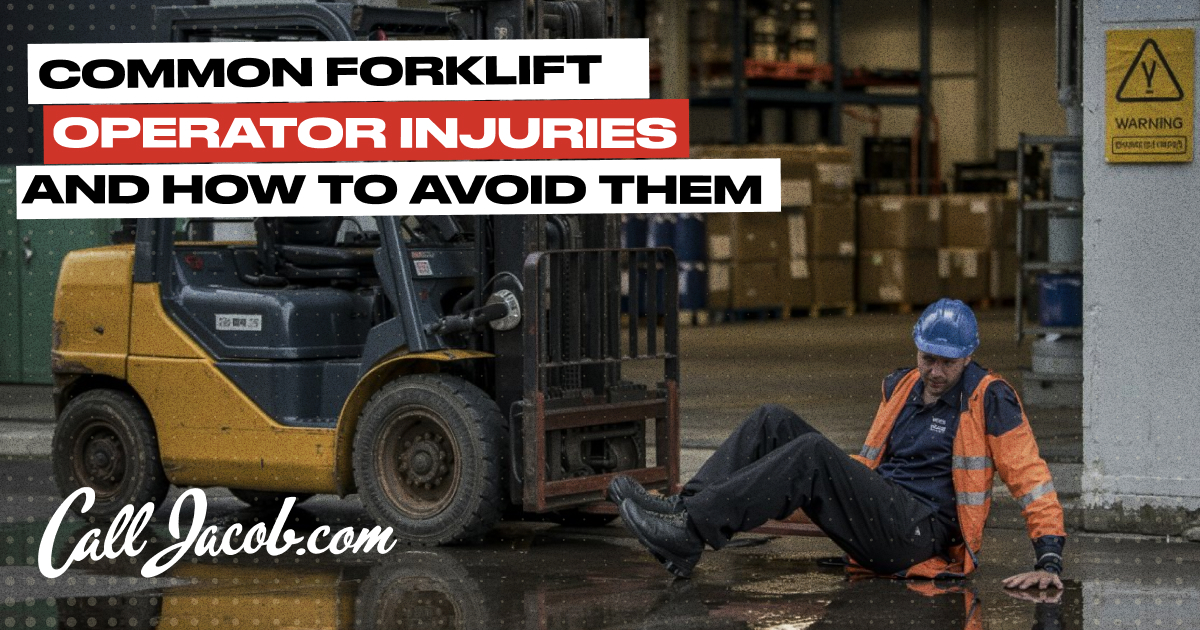Forklift operators support nearly every industry that deals with physical goods, whether construction, shipping, or warehousing. Proper training, certification, and workplace safety standards minimize the risk of common forklift accidents and consequent injuries. If you’re injured on the job, understanding how these injuries occur and your legal options can help strengthen your case.
Common Forklift Operator Injuries
Forklift-related injuries affect many workers yearly, with the Occupational Safety and Health Administration (OSHA) reporting nearly 1,200 severe incidents in 2022 and 2023 across various industry sectors. The most common causes of forklift accidents may result in worker injuries of varying severity, from minor sprains to traumatic brain injuries.
Musculoskeletal
Musculoskeletal injuries are common among forklift operators and may chronically or acutely affect muscles, tendons, ligaments, joints, and bones. Some develop gradually from poor seating ergonomics or posture, excessive machinery vibration, reaching or twisting while seated, or long hours in relatively stationary positions. Common musculoskeletal conditions in forklift operations include:
- Lower back pain, sciatica, and lumbar strain
- Neck and shoulder strain and reduced range of motion
- Arthritis
- Tendonitis or bursitis
- Herniated discs
Crush injuries
Crush injuries occur when body parts are trapped between objects, such as a forklift and walls, shelving, or other vehicles. These injuries may be traumatic and cause permanent damage and internal injuries. Crush injuries are typically the result of hazardous workplace environments or behaviors, such as:
- Narrow or crowded workspaces.
- No spotters in forklift blind spots.
- Poor visibility or dim lighting.
- Operator error during turns or parking.
Falls
Falls from forklifts during operation or maintenance can result in broken bones, spinal injuries, head trauma, and other serious conditions. Crossing thresholds, such as on docks and into trailers, are one of the main fall risks — for example, a truck that isn’t parked securely may roll slightly as the forklift enters or leaves the trailer, causing it to lurch or tip.
Forklift tip-overs are the number one cause of forklift-related injuries and falls. Other common causes of forklift-related falls include:
- Slick or damaged flooring
- Climbing or standing on elevated forks
- Distractions or slips while moving or exiting the vehicle
Collisions
Collisions with other forklifts, machinery, facility structures, or individuals are most likely in workplaces with high and fast-paced traffic. Even minor collisions can cause serious injuries, especially if the collision involves the forklift tipping over or trapping one or more workers.
Safety Training and Certification for Forklift Operators
Employers, property owners, and workplace site managers are responsible for forklifts and other machinery or vehicular safety. Depending on the circumstances, at least one of these parties must facilitate safe working conditions for forklift operators and others by ensuring adequate safety training and certification. That includes:
- Verifying proper operator training and evaluating their performance at least every 3 years.
- Evaluating the operator’s competency before operating the forklift in the workplace.
- Conducting or facilitating refresher training when the operator demonstrates a skill deficiency.
Forklift training and certification cover various topics, such as vehicle stability and capacity, operating warnings and precautions, steering and maneuvering, and vehicle limitations.
Preventing Musculoskeletal Injuries
Many long-term injuries come from repeated stress or strain, but they’re preventable with the right equipment and strategies. Employers should maintain standards that encourage or mandate certain employee behaviors, such as minimizing driving in reverse and promptly reporting health or workplace hazards.
Employers can also enable a safer workplace environment by:
- Using forklifts with seats that swivel and tilt to reduce twisting actions.
- Encouraging more regular breaks to prevent repetitive stress or sitting for long periods.
- Fixing rough or broken floor surfaces to reduce vibrations or abrupt movements.
- Installing anti-vibration seat cushions.
Avoiding Crush Injuries and Collisions
Reducing the risk of crush and collision injuries requires workplace-wide procedures that promote worker health and safety. The workplace should adhere to inspection and maintenance standards to avoid equipment malfunctions, and operators should follow proper procedures for unloading and loading the forklift.
In addition to ensuring that forklift operators and employees follow safety standards, employers should also reduce hazards in the workplace. Consider these examples:
- Establishing clear forklift routes.
- Enforcing standards for clear and obstruction-free walkways and work areas.
- Installing mirrors and lighting to improve visibility.
Preventing Falls and Tip-Overs
Falls and forklift tip-overs often share the same root causes — improper load handling, neglecting safety equipment, and rushing in unsafe environments. Workplaces should uphold these best practices:
- Operate the vehicle according to the manufacturer’s instructions.
- Always wear a seatbelt or safety restraint when operating a forklift.
- Never stand on forks or pallets to reach elevated areas.
- Don’t raise or lower loads mid-travel.
- Use proper footing and handholds to enter and exit the vehicle.
- Respect the forklift’s load rating and avoid overloading.
- Move slowly on ramps or uneven surfaces and keep the load uphill.
- Use fall protection gear when working at height.
Emergency Response and Reporting Procedures
The initial and long-term response to workplace injuries and incidents affects one’s ability to recover. To protect workers and improve overall workplace safety, workplaces should have clear processes for reporting injuries, unsafe conditions, and equipment faults.
Workers should report injuries immediately, even if they seem minor. Delays can make recovery harder and weaken future workers’ compensation claims. Likewise, equipment malfunctions and near misses should be documented to prevent future harm and establish employer responsibility.
When an accident happens, victims should seek immediate medical attention. Most employers or supervisors must comply with OSHA record keeping and reporting requirements, which include reporting hospitalizations of workers within 24 hours. The report should include:
- The time, date, and location of the accident.
- Name and job title of the reporting individual.
- Employer’s name, address, and telephone number.
- Name and contact information of the injured employee.
- Nature of injuries.
- The facility where the employee received medical attention.
Contact The Law Offices of Jacob Emrani Today
Whether your injury resulted from insufficient training or unsafe working conditions, our Los Angeles workers compensation attorneys at the Law Offices of Jacob Emrani are here to help. Our team investigates the facts, protects your rights, and helps you achieve fair compensation — call (888) 912-7115 to set up your no-cost case evaluation.




